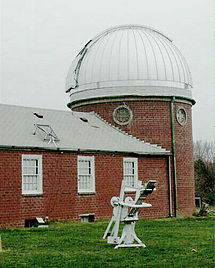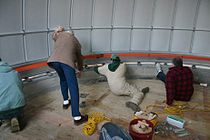- Custer Observatory
-
Custer Observatory 
Custer Observatory DomeOrganization Custer Institute Location Main Bayview Road, Southold, New York Coordinates Installation of new dome (2007)[3]
Installation of new dome (2007)[3]
Custer Observatory is an astronomical observatory owned and operated by Custer Institute. Located in Southold, New York (USA), facing Peconic Bay and Shelter Island, Custer's location boasts some of the darkest skies on Long Island.[1]
Long Island's oldest public observatory, Custer Institute was founded in 1927 by Charles Wesley Elmer (co-founder of the Perkin-Elmer Optical Company), along with a group of fellow amateur-astronomers. The name was adopted to honor the hospitality of Mrs. Elmer, the Grand Niece of General George Armstrong Custer. In 1942, the Custer Institute was incorporated as a non-profit educational corporation in the State of New York.
In 1938, the group purchased the land the institute presently occupies and initial construction was completed in the spring of 1939. The 100-seat lecture hall was added in 1945. In 1947, through donations by Charles Elmer and Mr. Polk, the 3-story tower/library and observatory dome were built. In 1954, Charles Elmer died; that same year, the Institute added the shed, which houses three sliding roof observatories. Over the years, Custer has acquired a large collection of telescopes of all sizes and descriptions. Most recently, this includes a 25-inch (f/5) Newtonian reflector, which is now the premier telescope in the newly-rebuilt dome.(Article not found) This telescope will soon come to represent a one-of-a-kind optical system; the result of the latest optics research and innovation conducted at the Custer Institute.
Contents
Search for extrasolar planets
Recently, the Custer Institute and Observatory began a new research project to search for new extra-solar planets using data collected by amateur astronomers, with sophisticated mathematical algorithms to remove variations in sensitivity, noise level, and other important variables. Very promising preliminary results have already been obtained, but more volunteers are needed, with CCD cameras attached to 8-inch (or better) telescopes, located anywhere in the Northern Hemisphere. (The task is to allow their equipment to take multi-hour, high-quality images of specified areas of the sky).[2]
The Custer Library
On the first floor of the dome tower building is located the Custer Library. It contains a wealth of Astronomy and Science books dating from the 19th century to the present. It also houses the Institute's videotape collection and 35mm astronomical slide collection. It contains National Geographic, Sky & Telescope, Astronomy, and Scientific American magazines dating back numerous decades. Membership to the Custer Institute grants access to their library.
The Custer Museum
On the second floor of the dome tower is located the Custer Museum. Among the items in the collection, open to viewing by the visiting public, can be found:
- Henry Fitz, early Custer member and famous telescope mirror maker's Grinding Table. (Similar to the one on display at the Smithsonian in Washington, DC.)
- James Short's circa 1750 Gregorian telescope variation designed to read the separation of binary stars. One of only three known to exist.
- Various other 18th and 19th centuries vintage spectrometers and sextants, along with other astronomical devices.
- The Custer Rock Collection including geodes and numerous Fossilized Rocks.
- The Custer Meteorite Collection, which includes a Shergottite from Mars.
- Numerous astronomical, sunspot, and aurora pictures taken by past and present members.
- A broken 1750s roadside Mile Marker, recovered by Custer members that was originally ordered by Ben Franklin when he was the head of the Colonial Mail system.(Today, most of the other markers, still undamaged, mark the distance along the Main Road between Orient Point and the Old Riverhead Court House.)
- The Custer Civil War Bullet Collection.
- A piece of a tree that was originally planted at Bronx College by Albert Einstein (who often summered in Southold).
Telescopes
Custer has a large collection of telescopes of all sizes and description. Among them are:
- Obsession 25" Newtonian reflector (on loan from Suffolk Community College).
- Meade 16" LX200GPS-SMT (currently away for maintenance).
- Celestron CGE-1400 14" Go-To Schmidt-Cassegrain telescope with German equatorial mount. This telescope currently serves as the observatory's research instrument and is outfitted for remote operation and viewing.
- Meade 14" LX200GPS-SMT.
- 10" Astro binoculars, designed and built by one of the observatory members, Rico Verticchio, and on loan to Custer.
- 6" Alvan Clark Refractor circa 1900 with a Northwestern University equatorial mount circa 1895.
- 12½" Newtonian reflector
- 12" Springfield designed by Russell Porter.
- 12½" Newtonian.
- 13" Newtonian Dobsonian.
- 8" Schmidt Newtonian.
- 8" Classic Cassegrain.
- 7" f/20 refractor.
- 5" Alvan Clark Student Model refractor.
- 4" Unitron. [This telescope has been missing for several years.]
- 7x21 Ross Camera, f/7 with a 3" lens, accepting 8x10 and 4x5 inch plate film.
- 10½" Newtonian reflector.
Public access
Generally the Custer Institute is open every Saturday evening, from dusk until midnight. Custer Observatory welcomes the general public to guided tours of the heavens—weather permitting.[3] The Custer Institute also allows its lecture hall to be used for lectures, in-service courses for educators, concerts, theatrical performances, and other events.
Images
See also
- List of observatories
References
- ^ See the light pollution map [1] on ClearSkyChart.com. Note that there is still quite a bit of light pollution compared to northern New York and other parts of the Northeast.
- ^ Custer Institute searches for extrasolar planets .(Note: Format Error. Or may be corrupted pdf)[dead link]
- ^ Custer's current schedule of upcoming events (Consult the clear-sky-chart for current & predicted conditions.)[2]
- "Custer Observatory Homepage". Custer Index | Web page designed by David van Popering. http://www.custerobservatory.org/. Retrieved August 19, 2009.
- "Montauk Observatory Project". http://www.montaukobservatory.com/. Retrieved August 19, 2007.
External links
- Custer Institute Clear Sky Clock Forecasts of observing conditions.
Categories:- Astronomical observatories in New York
- Buildings and structures completed in 1947
Wikimedia Foundation. 2010.




